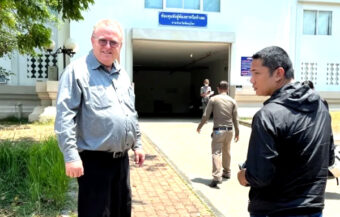The kingdom’s economy will have to begin adapting its stance to cope with more old people and less working adults while still remaining a relatively poor country. It may also mean more migrants entering the kingdom and perhaps higher taxation. However, time is running out and one Stanford University expert says that things could begin to look ‘bleak’ if something is not done to address the country’s rapidly looming fertility crisis.
Thailand is on target to be the first large country in the world to suffer a sharply ageing and declining population without having become wealthy. It comes as the government, this week, rolled out a programme of support for those having children to address the oncoming crisis of rising costs to care for seniors and a declining pool to underpin economic growth. Many experts have identified Thailand as facing a unique crisis or as one expert put it: ‘Thailand is kind of stuck in the middle: It’s an emerging country and yet it faces the demographic headwinds you see in advanced economies.’ The country’s fertility rate is now 1.5, already well below the 2.1 needed for population replacement, and falling fast. It is lower even than China at 1.7 after its one-child policy and that of Norway at 2.1 which is one of the wealthiest countries in the world.

Thailand is facing a demographic crisis in about 15 years as things currently stand as the number of workers to cope with a rapidly ageing population dwindles.
By 2030 or nine-years from now, over 25% of the Thai population will be over 60. The kingdom is on target for a world first.
It will be the first large country in the world outside China to experience a rapidly shrinking and ageing population while also remaining a developing economy with annual per capita earnings which are less than 12% of many wealthy European and Scandinavian countries as well as the United States. Thailand’s GDP per capita of $7,806 compares to $65,297 for the United States and a range of $50,000 to $80,000 in European countries.
Many economists are quietly questioning half a century of economic thinking pushing birth control
The looming problem has caused many leading economists to quietly question the accepted wisdom of the last 50 or 60 years which identified overpopulation as the critical problem facing the world to a situation in 2021 where countries such as Thailand are now facing ballooning health costs in hospitals and the public health system at the same time as the labour pool is in free fall and economic prospects for growth are limited by declining adult population numbers.
The kingdom’s birth rate fell below 600,000 last year with the fertility rate still declining after falling by over 77% since 1960. This change is now set to usher in major consequences for Thai society and its economy over the next decade.
Thailand saw rapid urbanisation offering women new opportunities and vistas since 1960
Someone got it wrong and the problem is not going to be so easily corrected. Thailand, like China, has seen massive urbanisation since 1960 which has opened up opportunities and vistas for women meaning they are, like their counterparts worldwide, reluctant to have children.
‘I don’t want to have a lot of kids if I can’t guarantee I’ll be able to give them a good life,’ Nandini Sehgal, a Bangkok advertising worker explains.
Top health professional warns of Thai women leaving it too late to have children in today’s age
Dr Kamthorn Pruksananonda works with a committee at the Royal Thai College of Obstetricians and Gynaecologists which is looking at reproductive medicine. He says the average Thai woman seeking infertility treatment is now 38 years old.
He explains the phenomenon of women leaving it too late in their career to have a baby is not only driving down the birth rate but it is also leading to more abnormalities in babies being born.
‘When Japan’s TFR hit 1.6, the Japanese leader at the time announced that a disaster was on the way if the country didn’t do anything about it, Dr Kamthorn explained. ‘Thailand’s TFR used to be 5.1 and it has declined all the way down to 1.5. Worse still, the country has still not done anything about it and, without any intervention, the rate is forecast to fall further to 1.3 in less than a decade.’
Thailand – one of the countries most challenged
Chua Hak Bin of Maybank Kim Eng Research Pte put it like this just after a UN study identified Thailand as one of the country’s most challenged by the phenomenon because it has not yet become an advanced economy but has a birth rate of 1.51, lower than China and lower than the 2.1 which is the minimum for sustaining the population now enjoyed for instance, by Norway, one of the richest countries in the world.
‘Thailand is kind of stuck in the middle: It’s an emerging country and yet it faces the demographic headwinds you see in advanced economies,’ the leading Singapore based economist said.
On target to have only 46 million people by 2100 or a decline of a third of what the population is now
Thailand’s birth rate is even below the 1.7 rate seen in China which Chinese planners now recognise as a disaster leading them to scrap the communist country’s infamous one-child policy.
At the current rate, by 2100, Thailand’s population will have been reduced by a full one third from the 70 million it stands at today. That is just above 46 million people.
May need incoming migration to plug the gap
One obvious answer to this, as it has been in mainland Europe, is to open the kingdom to more immigration. Currently, 10% of the Thai workforce is already composed of migrant labour.
‘Foreign workers are more than willing to fill the gap,’ Pakpoom Srichamni the boss of Sino-Thai Engineering & Construction Pcl told Bloomberg News in 2019. He explained that 30% of the company’s 10,000 strong workforce is already non-Thai.
The problem, as we have seen in Europe, is that the arrival of large numbers of immigrant workers is bound to pose social challenges.
In addition, there are already signs that this pool of labour may, in the future, dry up as countries like Cambodia and Vietnam have economies that are growing faster than Thailand.
Demographics expert at Stanford University says time is running out for the kingdom to act with urgency
Thailand, on Saturday, announced that 540,000 illegal migrant workers had registered with the Ministry of Labour for an amnesty scheme which will allow them to remain in the country with the knowledge of authorities.
A demographics expert at Stanford University Shripad Tuljapurkar has warned that the government in Thailand is running out of time to urgently develop the economy and expand the country’s tax base to cope with the funding required to take care of a growing senior population.
‘If they miss this opportunity,’ he said. ‘Things are going to look pretty bleak.’
Economic costs of ageing – can Thailand cope?
The Thailand Development Research Institute produced a study which shows a 12% rise in expenditure per annum on Thailand’s public health system over the last 12 years.
This will rise even further with an increasingly ageing population. This may inevitably mean recourse to a wider tax base and more taxation.
While Thailand may not have the same per capita income as developed western economies, neither has it the same labour costs and previous governments in the kingdom have worked hard to keep medical costs also low.
Thailand also has a societal tradition that sees families assist their seniors. While the kingdom’s low-cost public health infrastructure may not be as comprehensive as western developed countries, it may be sufficient.
The country has shown itself even during the Covid-19 crisis to have an inherent capacity to handle public health and care challenges which may yet see it manage to defy the commentators.
At the end of the day, a question for Thai women
Nonetheless, the country faces a significant challenge over the next 10 to 15 years which it cannot shirk.
This week, Deputy Minister of Public Health Sathit Pitutecha announced new supports for families and couples who have young children with a programme to assist the birth of children and their upbringing until they are 18 years of age.
One thing is for sure, there is no going back to 1960 when the Thai fertility rate was 6.6. It fell in the following three decades to 2.2 in 1990 and is now at 1.51.
While the government’s plan, appropriately emphasised approaching Valentines Day, may help, the solution to the problem, if there is to be one, lies ultimately with Thai women who like women throughout the world right now, have other notions.
Join the Thai News forum, follow Thai Examiner on Facebook here
Receive all our stories as they come out on Telegram here
Follow Thai Examiner here
Further reading:
Thailand’s new move to boost the birth rate and fight the negative impact of an ageing population
Denmark and Thailand seek economic partnership and face the same challenge – demographics
Thailand’s new move to boost the birth rate and fight the negative impact of an ageing population
BCG economic and social blueprint over the next 5 years unveiled, promises more money for less
Noble spirit of Thailand’s elderly helps country deal with demographic problem
Thailand to launch a moon space programme to boost efforts to become a high-income economy
Finance Minister says economy must pivot away from tourism with a switch to S-Curve industries
Strengthening baht predicted as investors bet on a reopening of Thailand to mass tourism in 2021
World’s biggest free trade deal just signed will be a huge boost for the Thai economy and exports
Prime Minister indicates that the cabinet reshuffle will be complete very shortly with no problem
Thailand’s economy has become dependent on government expenditure to stay above water
Thailand and US aim for a new more ‘proactive’ trading relationship as ambassador meets Prayuth
Rice price spike but drought conditions to recede – security concern for the Mekong river
US suspension of Thai preferential trade partner status part of Trump’s ongoing trade war


















